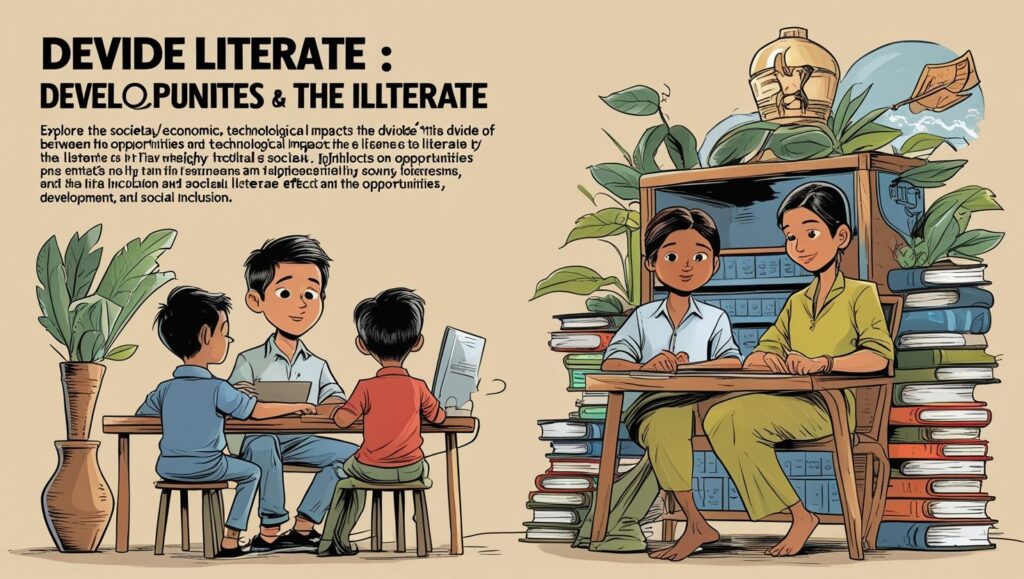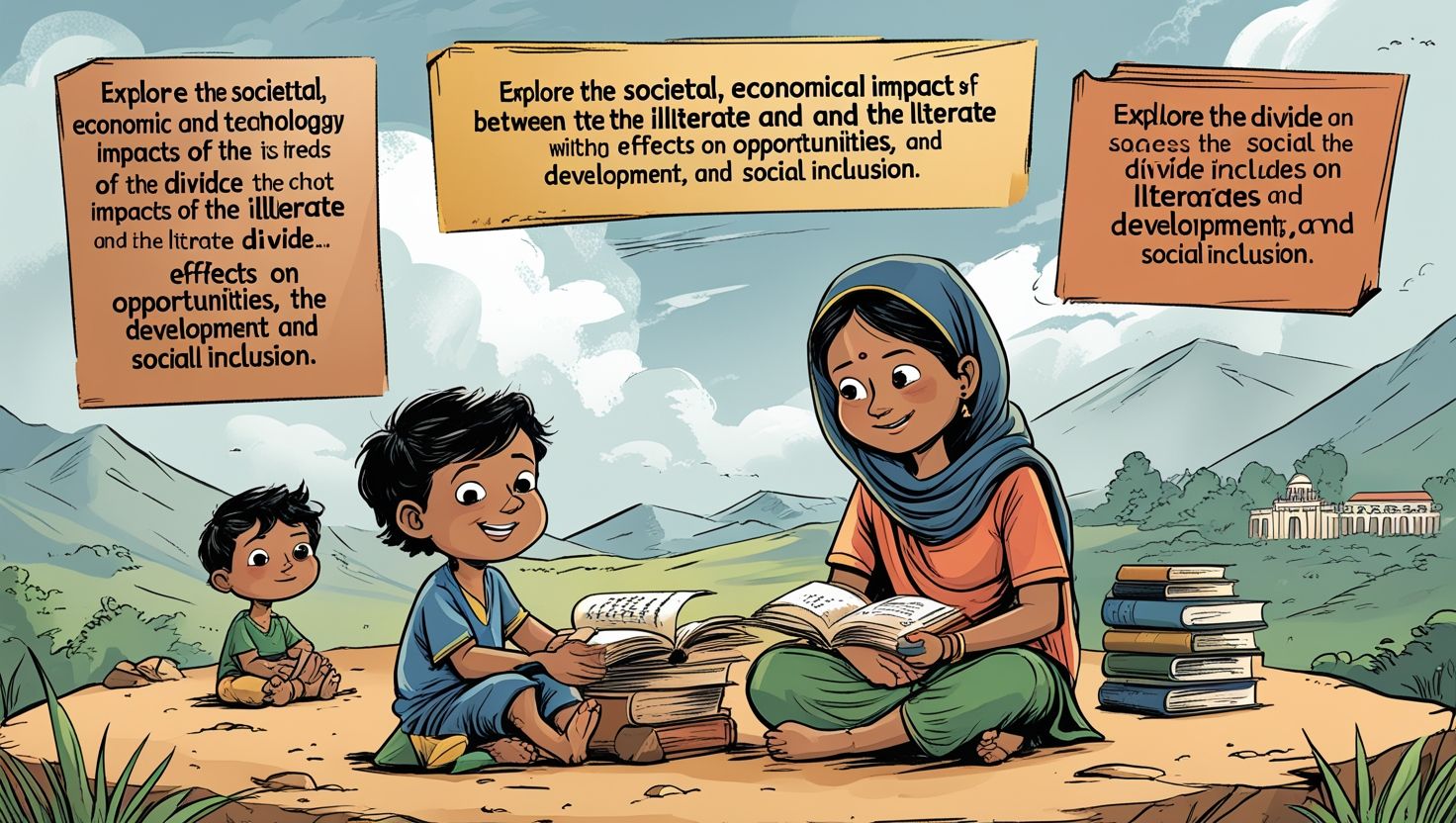The Divide Between the Literate and the Illiterate, In the modern world, literacy is often taken for granted. The ability to read and write is considered a basic human right and a fundamental skill necessary for personal and societal development. However, the divide between the literate and the illiterate remains a significant issue, impacting individuals, communities, and nations. This article explores the implications of this divide, the challenges faced by the illiterate, and the broader societal consequences of literacy disparities.
Understanding Literacy and Illiteracy
Literacy is commonly defined as the ability to read and write at a level sufficient for communication and comprehension. It is not merely the mechanical act of decoding symbols but also the capacity to understand, interpret, and use written information effectively. On the other hand, illiteracy refers to the inability to read or write, often due to a lack of access to education or resources.
While global literacy rates have improved significantly over the past century, illiteracy remains a pressing issue, particularly in developing countries. According to UNESCO, approximately 773 million adults worldwide lack basic literacy skills, with two-thirds of them being women. This disparity highlights the intersection of literacy with gender, socioeconomic status, and geographic location.
The Impact of Illiteracy on Individuals
For individuals, illiteracy is a barrier to personal growth and opportunity. Illiterate individuals often face challenges in navigating daily life, from reading street signs and filling out forms to understanding medical instructions or legal documents. This lack of basic skills can lead to feelings of isolation, low self-esteem, and dependency on others.
Education is a key driver of economic mobility, and illiteracy severely limits an individual’s ability to access better job opportunities. Illiterate individuals are often confined to low-paying, manual labor jobs, perpetuating cycles of poverty. Furthermore, illiteracy can hinder participation in civic activities, such as voting or understanding one’s rights, thereby marginalizing individuals from the democratic process.
The Societal Consequences of Illiteracy
The divide between the literate and the illiterate has far-reaching consequences for society as a whole. Illiteracy is not just an individual problem; it is a societal issue that affects economic development, public health, and social cohesion.
- Economic Development: Literacy is a cornerstone of economic growth. A literate workforce is more productive, adaptable, and capable of contributing to innovation and technological advancement. In contrast, high illiteracy rates can stifle economic progress, as a significant portion of the population is unable to participate fully in the economy. This creates a drag on national development and exacerbates income inequality.
- Public Health: Literacy plays a crucial role in public health. Illiterate individuals often struggle to access and understand health information, leading to poorer health outcomes. For example, they may have difficulty reading medication labels, understanding vaccination schedules, or following hygiene practices. This lack of health literacy contributes to the spread of preventable diseases and places a greater burden on healthcare systems.
- Social Cohesion: Literacy fosters social inclusion and cohesion by enabling individuals to communicate effectively, access information, and participate in community life. Illiteracy, on the other hand, can lead to social exclusion and marginalization. Illiterate individuals may feel disconnected from society, leading to a sense of alienation and, in some cases, social unrest.

The Role of Education in Bridging the Divide
Education is the most powerful tool for addressing the divide between the literate and the illiterate. Access to quality education can empower individuals, break the cycle of poverty, and promote social and economic development. However, achieving universal literacy requires a multifaceted approach that addresses the root causes of illiteracy.
- Early Childhood Education: Investing in early childhood education is critical for laying the foundation for literacy. Children who receive quality early education are more likely to develop strong reading and writing skills, which set them up for success in later life. Governments and organizations must prioritize early childhood education programs, particularly in underserved communities.
- Adult Literacy Programs: For adults who missed out on formal education, adult literacy programs offer a second chance to acquire essential skills. These programs should be tailored to the needs of learners, taking into account their cultural context, language, and prior knowledge. Mobile learning platforms and community-based initiatives can make literacy education more accessible to adults.
- Gender Equality in Education: Addressing gender disparities in education is essential for reducing illiteracy rates. In many parts of the world, cultural norms and economic barriers prevent girls from attending school. Empowering women and girls through education not only improves their literacy but also has a ripple effect on their families and communities.
- Technology and Innovation: Technology has the potential to revolutionize literacy education. Digital tools, such as e-learning platforms, mobile apps, and online resources, can make learning more engaging and accessible. For example, interactive reading apps can help children develop literacy skills, while online courses can provide adults with flexible learning opportunities.
The Ethical Imperative of Literacy
Beyond its practical benefits, literacy is a matter of human dignity and equality. Every individual has the right to access education and acquire the skills needed to participate fully in society. The persistence of illiteracy is a reflection of systemic inequalities that must be addressed through collective action.
Governments, non-governmental organizations, and the private sector all have a role to play in promoting literacy. Policies that prioritize education funding, teacher training, and infrastructure development are essential for creating an enabling environment for literacy. Additionally, public awareness campaigns can help shift societal attitudes and highlight the importance of literacy.
The Way Forward
The divide between the literate and the illiterate is not insurmountable. With concerted efforts, it is possible to bridge this gap and create a more inclusive and equitable world. Literacy is not just a skill; it is a gateway to opportunity, empowerment, and human connection.
As we move forward, it is crucial to recognize that literacy is a lifelong journey. It does not end with the ability to read and write but extends to critical thinking, digital literacy, and the capacity to adapt to an ever-changing world. By investing in literacy, we invest in the future of individuals, communities, and nations.
In conclusion, the divide between the literate and the illiterate is a stark reminder of the inequalities that persist in our world. Addressing this divide requires a holistic approach that combines education, policy, and innovation. By working together, we can ensure that everyone has the opportunity to unlock their potential and contribute to a brighter, more literate future.

6 thoughts on “The Divide Between the Literate and the Illiterate”
Comments are closed.